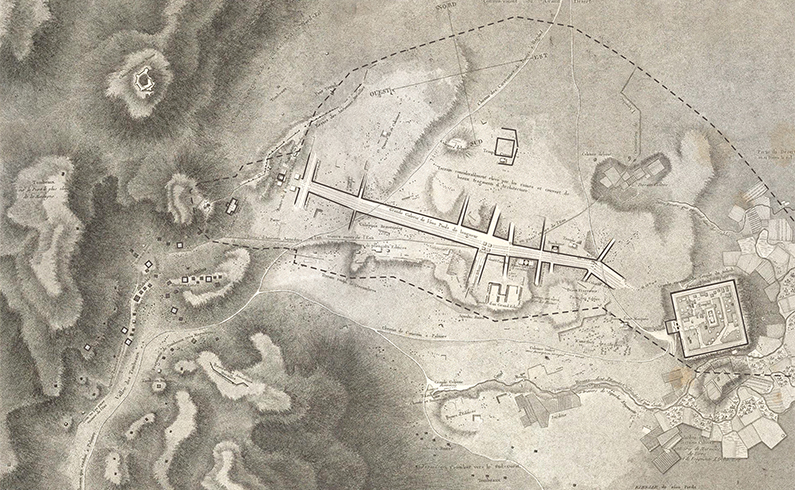
Sections
- Modern Archaeology
- Palmyra Today
Back to top 

Cite this exhibition
Exhibition URL: www.getty.edu/palmyra
Cite this page
Terpak, Frances; Bonfitto, Peter Louis, The Legacy of Ancient Palmyra, Palmyra in the Modern Era,
accessed ,
https://www.getty.edu/research/exhibitions_events/exhibitions/palmyra/palmyra_today.html

Early pictorial works featuring Palmyra, like those of Cassas and Vignes, combined with the rise of travel descriptions by amateurs, increasingly inspired explorers and scholars in the late 19th century to travel across the desert to the ancient caravan city. As tourist photographs of the site began to circulate more widely, so did Palmyra's artifacts, especially the famous funerary portrait busts (some of which are featured in this exhibition). Today, one can see thousands of Palmyrene antiquities outside the region: in American, Western European, Russian, and Turkish museums that had been secured during the late Ottoman rule (1876–1922) and subsequently during the French Mandate (1923–46). Debate still persists about the collecting practices of this period, characterized negatively as colonialist or state-sanctioned looting on the one hand, and positively as a means to preserve and disseminate knowledge about the past on the other.


Nineteenth-century curiosity about Palmyra's monuments, sculpture, and inscriptions transformed into professionalized archaeology by the turn of the 20th century. Starting in 1902, German excavations were undertaken to more fully understand the extent of the ancient metropolis. After World War I, Syria became a protectorate of France and foreign teams worked in collaboration with the Antiquities Service of Syria and Lebanon. French, Danish, and Syrian archaeologists, in the interwar period, conducted important excavations of the western necropolis, cleared the Temple of Bel, and moved many antiquities to the museum in Damascus. With Syria's independence in 1946, research was expanded considerably on both a national and international level, as Swiss, Polish, and Japanese teams initiated projects with their Syrian colleagues. In 1961 the depot for antiquities at the site was transformed into the Palmyra Museum; in 1980 Palmyra was designated as a UNESCO World Heritage site.

Zoom not available

Zoom not available
These archaeological projects significantly changed the physical landscape of Palmyra. Prominent buildings, like the theater, baths, and banquet halls, were unearthed as the streets jutting off the Colonnade Street were traced out from the ground. Complementing the extant ruins of the Temples of Bel and Baalshamin, foundations for temples which had not survived were discovered and interpreted as important elements of the city's urban fabric. Excavations of marketplaces, grand residences, and civic centers have revealed much more about the daily life of the Palmyrene people. In turn, exploration into the above- and below-ground tomb systems have brought to light enumerable funerary artifacts. Besides altering the topography of the site by digging, large-scale restoration efforts of the 20th century had re-erected scores of columns and reset architectural blocks remaking the ruins into a modern-day archaeological park. The vast quantity of material that was underneath Cassas's feet, as he surveyed the site, or obscured from Vignes's lens is a testament to the hard work and dedication of generations of archaeologists who have endeavored to study Palmyra.

Zoom not available
“It is the natural and common fate of cities to have their memory longer preserved than their ruins. Troy, Babylon and Memphis are now known only from books, while there is not a stone left to mark their situation. But here we have two instances [Palmyra and Balbeck] of considerable towns out-living any account of them. Our curiosity about these places is rather raised by what we see than what we read, and Balbeck and Palmyra are in a great measure left to tell their own story.”
–Robert Wood, 1753
As Wood so astutely observed, the scale and skill employed in constructing ancient Palmyra gave its ruins the ability to withstand the turmoil of multiple epochs, while continuing to bear testimony to the extraordinary culture that formed this oasis metropolis. The intentional destruction of Palmyra's best-preserved monuments by ISIS in 2015 and 2017 was an attempt to erase its illustrious history and deprive current, and future, generations access to these remarkable vestiges of a past civilization. As appalling as this iconoclasm seems, it was sadly only part of the atrocities carried out during the occupation of the site. Many contemporary Palmyrenes, including Khaled al-As’ad, Palmyra's retired director of antiquities and guardian of the site for half a century, were brutally executed. The group has also made public videos showing the smashing and breaking of statues held by museums, while secretly looting and selling others on the black market to fund their activities.
The devastation unleashed in Syria today forces a renewed interpretation of the early prints and photographs presented here. They gain more significance as examples of cultural documents that can encourage a deeper investment in understanding humanity's past achievements relevant to all historic sites. Understanding Palmyra through these invaluable accounts preserves its memory and connects us with its grandeur and enduring legacy.


Banner image:
Next
Additional Resources
Previous
Rediscovery of Palmyra